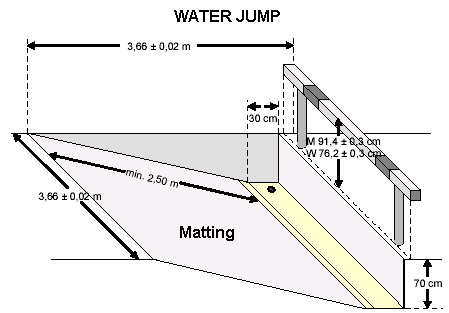 | WATER JUMP
The steeplechase water jump has two components: a barrier -- and a pit which is filled with water for competition.
The barrier is similar to the on-track hurdle, with three exceptions:
1. The barrier is fixed; it cannot be moved like a hurdle.
2. The top bar is 3.66m / 12 feet wide -- less than a hurdle.
3. The barrier is not positioned on the oval running track; instead it and the pit are on a separate steeple runway -- usually inside the track's inner curb Runners are directed to leave the track and use that runway as they approach their first water jump.
The pit is 3.66m (12 feet) square. The pit's forward-direction measurement starts from the approach edge of the barrier and ends at the point where the water jump slope reaches the flat surface of the steeple pathway -- as illustrated by the drawing above. Rulebook language simply but clearly says "The water jump, including the hurdle, shall be 3.66m in length." However, on-site measurement may reveal a pit too long, possibly because measurement was made from the wrong edge of the barrier.
Years ago during the dirt and cinder track era, before uniform steeple specifications were formalized, pits were almost flat and relatively shallow. Modern pits have an upward slope; the water is deeper near the barrier and is within 2 cm of ground level at the departure end. That slope begins approximately 30cm (11.8 inches) forward of the barrier at which point the water is 70cm (27.5 inches) deep.
The modern angled slope may not have been a good addition, because it creates potential for injury to a steepler's landing foot or leg, particularly if the surface is the same hard artificial material used for the running track -- instead of dirt or grass. (As landing surface angle increases, so does the sensation of "hitting a wall.") There are two mitigating procedures.
1. Athletes and their coaches should strive for keeping the body's center of gravity in front of the landing foot , even though this may require landing in slightly deeper water. Getting CG forward is a function of speed across the pit, obtained through acceleration on the approach to the pit and maintained by avoiding hesitation atop the barrier before push-off with one foot from the bar's front edge.
2. Meet venue managers can assure that the sloped surface is covered with matting "of sufficient thickness to afford a safe landing and allow for the spikes to grip satisfactorily" as described in Rule 169 (both IAAF and USATF). Such matting is similar to a thick door mat but has larger dimensions; look for it in a home-improvement store.
-- Drawing from German Federation. Text by James Fields. |
|